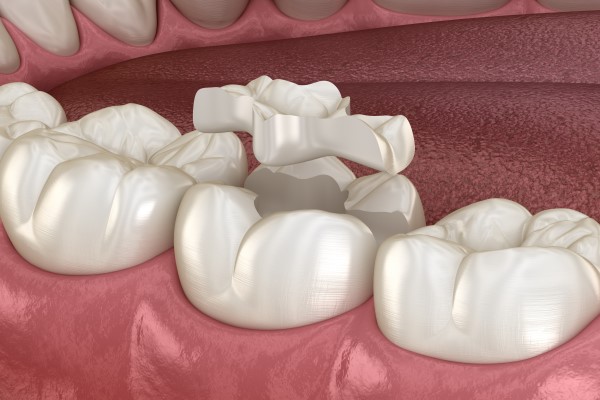When Would a Dentist Recommend a Dental Inlay?

A dental inlay is porcelain, gold, or composite material for repairing dental decay or damage. Your dentist can use this substance to repair a tooth with a type of damage not huge enough for a dental crown. An inlay can restore a healthy dental structure and provide enough support for chewing. If you want to know when your dentist would suggest a dental inlay, here are the details.
What a dental inlay is
A dental inlay is a pre-molded type of filling. A dentist will place an inlay in the center of the affected tooth. This is the common form of restoration for cavities. It concentrates on the central grooves of the tooth. Cavities with this type of filling do not worsen anymore.
The process of getting an inlay is simple and painless. The dentist will use a local anesthetic on the area to ensure the patient’s comfort. Then, the dentist will drill out the decayed parts and clean the cavity. Taking an impression of the top cavity will come next. The dentist will then send the impression to the lab.
An inlay is either composite resin or porcelain. The color always matches the color of the patient’s natural tooth. The effect of this restoration is almost undetectable. Inlays are stronger than regular dental fillings.
When a dentist would recommend a dental inlay
A dentist can suggest the application of an inlay for groove cavities. This is when bacterial activity concentrates on the top chewing surfaces of the back teeth. A dental inlay is for moderate to deep decay in these areas. The back teeth are difficult to clean. They are prone to decay, especially if the patient is fond of sweet treats.
Chipped or cracked teeth can also get an inlay. If a tooth is not repairable with a dental filling yet not enough for a dental crown or root canal procedure, then an inlay can be used. A dentist can recommend an inlay for a damaged tooth with the cusp intact. An inlay can also help a tooth with a weakened dental structure due to a large filling.
Types of inlays
Many patients prefer composite inlays. The material is easy to use. That is why dentists can apply it in one dental visit. A composite dental inlay gives a natural look to the treated tooth. It is almost an invisible restoration.
The most common inlay material is porcelain. Dentists use this to give patients tooth-colored repairs. Porcelain is durable. It is also stain-resistant. Patients do not need to worry about discoloration when consuming colored drinks and foods.
Gold is a high-quality material. Dentists do not use this type of dental inlay that much. Some patients do not like the color of gold, especially on teeth near the front. The high price of this material is due to its wear resistance, strength, and durability.
A dental inlay can restore the damage along the top central grooves of your back teeth
The chewing surfaces of the back teeth are prone to damage. These areas are difficult to clean. That is why cavities form here all the time. Treating the central grooves of a back tooth with an inlay can restore and protect that tooth. An appointment with your dentist can determine which type of dental inlay fits your needs.
Are you considering getting a dental inlay in the Marietta area? Get more information at https://www.mytotaldentistry.com.
Check out what others are saying about our dental services on Yelp: Dental Inlay in Marietta, OH.
Recent Posts
Tooth extraction is a common dental procedure where a dentist removes a tooth from its socket in the jawbone. While it may seem intimidating, these procedures are often necessary to maintain oral health and prevent further complications. Here are the two types of tooth extractions that dentists use to improve your smile and overall health.Simple…
A dental bridge is a tried-and-true way to replace missing teeth, restore chewing function, and protect remaining teeth from shifting. Modern materials, precise digital planning, and evidence-based protocols allow a bridge to blend seamlessly with surrounding teeth and support the health of the smile. With the right bridge design and care routine, patients can experience…
Tooth extractions are common dental procedures performed by general dentists. They can be a result of decay, disease, or a fracture. While the dentist may introduce it to preserve oral health, it is important to know what to expect during and after the operation.There are two types of tooth extractions, namely simple and surgical. Most…
When searching for a dentist near me, families are often looking for more than just convenience. Quality, comfort, and trust can all help them select the right dental provider. Working with a trustworthy dental practice that understands your entire family's needs can make a lasting difference in your oral health.Dental health has a direct link…


